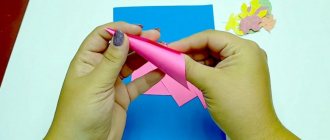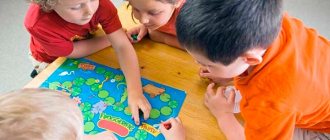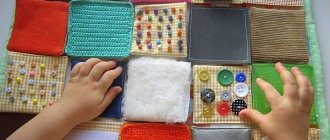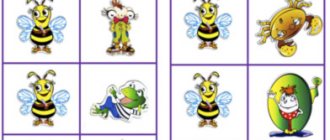In kindergarten, board games for children 3-4 years old, as well as toddlers and preschoolers, are not just a type of entertainment, but an important tool in the development of emotions, inner world, psychological core, and character. The main task of the teacher is to correctly select games that correspond to the age category of the children and their interests in the kindergarten. In modern “computer” times, children are often deprived of the opportunity to fully play at the table at home - looking at adults, they prefer phones, consoles, and televisions. That is why high-quality organization of tabletop leisure, introduced into kindergarten, is so important and relevant.
Board games for children 2-3 years old (younger group)
Children 2-3 years old often do not yet speak, do not recognize differences in colors and shapes, and do not know the names of objects. The teacher needs to offer such children board games to develop speech, visual and auditory perception, and attentiveness. The children cannot yet play together without the help of an adult, so the teacher acts as a coordinator and mentor in the kindergarten group.
Children of the younger group are very inquisitive and interested in everything new to themselves. Invite them to play bright pyramids, picture lotto, large puzzles, and build towers. Each game should be bright, beautiful and as safe as possible. No small parts (chips, cubes), sharp objects - the kindergarten by default should be a place where it is always safe for the child. You can make a finger theater with your own hands and offer to act out a scene with your children.
| “Guess and name” Pictures depicting various objects (fruits, transport, birds, etc.) come out of the box. The child must name what he sees. |
| “Where is whose house?” The kids’ task is to correctly match the animals with their habitat. These can be printed puzzles, purchased pictures, magnets or magnetic boards. |
| “The fourth extra” The excess is removed from the proposed options for animals, plants, insects, birds, food and other things. The child himself must determine the sign by which to make a choice - in case of failure, the teacher prompts, starting a speech from afar. |
Ready-made walkers for babies
If we talk about ready-made options available in stores, then “Cheese Run” (Ozon, Labyrinth, My-shop) seemed the most suitable for the role of the first walker. There are very few cells here - only 24, so the child definitely won’t have time to get tired. In addition, the kit includes a special cube for beginning accountants - the number of dots on it does not exceed three.
What I didn’t like about this board game is that it is not entirely clear to a novice player which direction to go now, all the cells are stuck together and therefore the direction is not obvious to the child.
Another good option is walkers from Umka (Ozon, My-shop, KoroBoom). The games are also simple and accessible, but there are significantly more cells, and the cube has very small dots, which presents some difficulty for a child who is just learning to count the cells and dots on the cube. So the games are more suitable for children who are seeing walkers not for the first time.
Games with cubes and chips are not the only thing that can be offered to a 2-year-old child. Here are some equally interesting options for board games for kids:
Board games for children 3-4 years old (middle group)
From the age of 3, a child already actively communicates with peers around him and is able to study and discover something together with them. At this stage, board games for children 3-4 years old can acquire new rules, and the teacher acts as an arbiter on the “field”. The joint activity is designed to develop a sense of justice - kids learn to rejoice not only in personal victory, but also in the success of their peers. The girl will be happy to enthusiastically play dress-up games, be it paper heroines with various homemade outfits or three-dimensional dolls. Dress up games can be fun not only for the sake of variety of leisure time, but also for the sake of understanding the principle and algorithm of putting on clothes. The boy will cope well with not the most complex construction set.
Those board games for children 3-4 years old that were successfully accepted by children in the younger group of kindergarten may be a little more complicated for the middle group. For example, the task set for the child will not just name the object in the picture, but give it a versatile characteristic (color, features, purpose). Develop children's speech by asking them to answer questions in detail, use facial expressions, and pronounce individual sounds.
| “My House” Children are offered separate parts of a house (door, windows, chimney, staircase) or room (sofa, chandelier, painting, refrigerator), which must be assembled into one structure. At the same time, each added detail must be voiced and reasoned. A 4-year-old child can make an arrangement using his own apartment as an example. |
| “Loto” Children are given cards with different images. From the common box, the teacher (or one of the children) takes out one chip at a time and names what is depicted on it. Kids should carefully study the cards for consistency. Whoever fills out their card correctly the fastest wins. |
| “Cubes” It is necessary to make pictures by matching all sides of the existing cubes. These are complicated puzzles. |
“Colorful caterpillars” (My-shop, Labyrinth, KoroBoom)
They have an excellent series of travel games that are compact and inexpensive. I would like to draw your attention to two games from this series - “Magic City” (pictured above) and “Colorful Caterpillars” (pictured below). Don't look at the fact that the box is marked 4+, it is clearly very overpriced. The games are perfect for children who are just starting to get acquainted with board games, because the rules here couldn’t be simpler.
“Caterpillars” and “Magic City” are very similar in essence. And although the rules contain several variants of the game, the process boils down to approximately the same - participants take turns throwing a multi-colored die and placing a piece of the corresponding color on their tower/caterpillar. The one whose design is longer or reaches a certain detail wins. Everything is simple and easy - just enough to get used to acting according to the rules.
Board games for children 5-6 years old (senior group)
Starting from the age of 5, children can be prepared for school: perseverance is cultivated, vocabulary and logic are developed, and an interest in creativity and acquiring knowledge is developed. At this stage, children can independently invent board games for themselves and introduce rules into them; the ability to analyze what is happening without the participation of an adult appears. For a preschooler, kindergarten is the last step before school, from which you need to get the most benefit.
For children aged 5-6 years, manufacturers have created many board games where it is necessary to find investigative connections and establish facts. Boys and girls can buy or create games based on the following topics: cars, house cleaning, fashion. It would be a good idea to introduce mathematical teaching materials so that children learn the basics of calculations before school.
| “Nature Calendar” The child needs to establish a correspondence between the selected months, its inherent precipitation, and temperature. |
| “Find a baby for mom” It is necessary to match the pictures of various animals, birds and their babies correctly. |
| "What? Where? When?" A versatile game for the development of 5-6 year old children. It is built on the principle of a quiz. |
The choice of board games for kindergarten children can be made not only by educators, but also by creative parents. The kindergarten, its atmosphere, talented employees, and even the boys and girls themselves are able to suggest what would be the most fun for them to play with at the table, and what kind of leisure time they generally consider the most interesting. This is an excellent help for studying, organizing free time, as well as an alternative to walking in bad weather.
Walking game “Visiting the Bunny” (with dice and chips)
I made this walker for my daughter when she was 2.5 years old. It became a wonderful help for us in mastering counting, and it just helped us have an interesting time together; my daughter simply adored the game. I recommend that you take this game into your arsenal, as it is made just for the little ones. You can read more about our walker and download it HERE.
Cat and mouse. Cheese hunt
The cat and mouse game is hard to Google. There are a lot of games with this name. By the way, cat and mouse from Step-puzzle and RN Toys are the simplest board games available even to one-year-olds.
The “Cheese Hunt” variation from Fortuna is a walking game with a plastic field and funny figures. The goal is to collect 5 pieces of cheese faster than other players and protect yourself from the cat. The manufacturer of the family game indicates an age of 4+, but you can play from 2 years old according to simplified rules, and after 3 years old - fully.
Game of cat and mouse. CHEESE CHASE. A cheap, almost identical analogue of the game “Cat and Mouse. Cheese Hunt" is found in Fix-Price!
Animal Tower
A cool little version of Jenga: build a tower of animals so that no one falls! yearlings can build the first beast towers , but in the competitive format the manufacturer labels them 4+ .
Board game ANIMAL TOWER - see the price in the Russian Federation. Analogue of the Animal Tower on aliexpress. A game of balance from Bustard - building towers from animals for the very little ones. Marking 2+ .
Fun races and ladybugs (Ozon, My-shop, KoroBoom)
Here's another simple game for little ones.
A game that teaches patience and perseverance. She also trains the child in simple counting, because during the game you will have to count the number of dots on the cube many times. The winner of the game is the one who collects his ladybug the fastest. Collecting it is not difficult - to do this, you need to roll the corresponding numbers on the die. If you throw out “1” you can take the body of a ladybug, if you throw out “4” you can take one eye, etc. At the same time, you must remember that legs can be attached only when you already have a body, and eyes, nose and antennae - when you already have a head.
Lotto (Labyrinth, My-shop, KoroBoom)
And, of course, don’t forget about everyone’s favorite classic games. You can start getting acquainted with lotto as early as one year, I have already written about this. Closer to two years, the child can not only put cards in the right places, but also play according to simple rules with his opponent. Let’s say that dad and child each receive a playing field, and mom takes cards out of the bag in random order (or almost randomly :)) and announces “Who has a hippopotamus?” The first one to collect all the cards on his field wins.
Lotto is also great because while playing you can unobtrusively study any interesting topic - animals, plants, professions, geometric shapes, etc. All names will be remembered by the child quickly and easily.
Bunnies (Ozon, My-Shop, KoroBoom)
This is a game that hooks children with almost 100% probability. Even if the kid doesn’t want to play by the rules, he will definitely enjoy putting together a fairytale field like a construction set and playing out simple stories on it. I think the main secret to the success of this board game is the 3D playing field, plus the interesting idea of harvesting in the garden.
To be honest, I bought this board game when my daughter was noticeably older than 2 years old (and she just stuck to it). But I’m including it in the selection of games for the little ones, because we took out the game many times when the kids came to visit, the game always went with a bang. Here the child only needs to count within three, the rules are also simple (only parents need to figure it out first, because the instructions are written quite intricately).
The main objective of the game is to go into the garden through a free hole in the fence and pick cabbage or carrots there (depending on the number of dots dropped). You need to quickly go home with your catch, and then go again for the next portion. Naturally, the winner is the one who reaps the most significant harvest.
Quick cups
Game from Fortuna for children from three years old . The goal is to arrange the cups in the order shown in the picture as quickly as possible and ring the bell. In total you need to play 24 speed cards. Actually, the principle is similar to the two previous games from Bondibon, but there is a competitive element .
Board game QUICK CUPS at Myshop/Labyrinth
Educational game Djeco “Numbers” (Ozon, My-shop)
A very good set for practicing your very first counting skills. The rules present as many as 4 variants of the game, both the most banal (combine numbers and quantities) and the most common ones. We especially liked one of them. Here's the gist of it: each player takes a playing field with empty silhouettes of animals. When throwing the dice, players must fill their fields with chips. We place the number of chips on the field as many as the dice shows up. Moreover, on the last move, exactly as many dots should appear on the cube as there are empty cells left on the field; if you are unlucky, we wait for the next move. Naturally, the winner is the one who is the first to completely collect all the kittens/puppies/hares/ducks.
The number of dots on the cube does not exceed three, so a 2-year-old child can easily handle the counting.
The execution of the set, as usual from Djeco, is excellent, the chips and cards are pleasant to hold in your hands, they are durable and will definitely last a long time. Still, the price for Djeco “Numbers” seems to me too high, and it’s not easy to find a set on sale lately, so I’m posting a scanned version of the game just in case. The kit can be DOWNLOADED HERE .
Memory (KoroBoom, Labyrinth, My-shop)
I think this game is also familiar to everyone from childhood. Here you can also try playing alone first, and then together. For those who are not familiar with the rules, I will briefly explain. A certain number of cards are taken, for example, 8 to start with, laid out on the table with the pictures facing up, and the name of each picture must be spoken out. Next, all the cards are turned face down and you need to remember from memory where each picture is. If two people are playing, then each player takes the cards they guessed, and at the end of the game they are counted.
In memory games, all the cards can be different (in Shichida’s method this is called a memory grid), or they can be paired (then the goal is to find pairs). Taisiya and I began to master the first memory at 1 year 9 months, starting with a small number of cards. At this age, the essence of the game is already clear.
Memory, like lotto, helps you learn new concepts and topics. For example, if you choose cards with exotic animals, during the game you can get acquainted with unfamiliar species of animals, etc.








